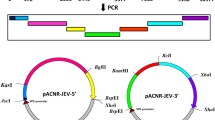Summary
Gliotoxin was shown to exert a less inhibitory effect on standard virulent type 1 and 2 poliovirus strains than on attenuated homotypie strains. This did not apply to type 3 standard strains since the virulent Saukett virus proved to be inhibited to the same degree as the attenuated Leon 12a1b, WM III and USOL D bac strains. An increase in gliotoxin-resistance after several intra-human passages of different live polio vaccine strains occurred only in a vaccinee fed the type 1 LSc2ab strain.
A strong correlation between the gliotoxin marker and therct/40 andMS characters was found in type 1 and 2 poliovirus strains isolated from patients and vaccinees. No correlation was observed between thegli marker and thermoinactivation at 50°C or sensitivity to dextran sulphate, guanidine and HBB.
The covariation between therct/40 andgli characters seems to be asymmetrical sincegli r mutants of the LSc2ab strain maintained theirrct/40 − character, whilerct/40 + mutants of the same parental strain displayed increased gliotoxin-resistance. The value of thegli marker for genetic and epidemiological studies is discussed.
Similar content being viewed by others
References
Aubert-Combiescu, A., D. Sergiescu, andF. Horodniceanu: A drug gradient plaque test for the study of the behaviour of animal viruses towards synthetic inhibitors. Arch. ges. Virusforsch.18, 111–115 (1966).
Bengtsson, S.: Mechanism of dextran sulphate inhibition of attenuated poliovirus. Proc. Soc. exp. Biol. (N.T.)118, 47–53 (1965).
Bengtsson, S.: Counter-current distribution of poliovirus type 2 and 3. Acta path. microbiol. scand.68, 68–80 (1966).
Cooper, P. D.: Genetic analysis of animal viruses. New approaches and new vistas. Brit. med. Bull.23, 155–160 (1967).
Cooper, P. D., E. T. Johnson, andD. J. Garwes: Physiological characterization of heat-defective (temperature-sensitive) poliovirus mutants: preliminary classification. Virology30, 638–649 (1966).
Horodniceanu, F., D. Sergiescu, R. Klein, M. Zamfirescu, andA. AubertCombiescu: Characters of guanidine resistant mutants of type 1 poliovirus. Arch. ges. Virusforsch.14, 238–252 (1964).
Kanda, Y., andJ. L. Melnick:In vitro differentiation of virulent and attenuated polioviruses by their growth characteristics on MS cells. J. exp. Med.109, 9–24 (1959).
fnKlein, E., and M.Teodorescu: Conditions affecting the expression of the MS marker of some poliovirus vaccine strains. Progr. Biol. Standard.3, (1968) (in press).
Klein, E., M. Teodorescu, andD. Sergiescu: Thermodependence of the growth of attenuated type 1 poliovirus in MS cells. Arch. roum. Path. exp.25, 905–910 (1966).
Larin, N. M., M. P. Copping, R. H. Herbst-Laier, B. Roberts, andR. B. M. Wenham: Antiviral activity of gliotoxin. Chemotherapia (Basel)10, 12–13 (1965).
Miller, P. A., K. P. Milstrey, andP. W. Trown: Specific inhibition of viral ribonucleic acid replication by gliotoxin. Science159, 431–432 (1968).
Pagano, J. S., V. G. Raymond, andW. D. Sedwick: The specificity and interaction with poliovirus of an inhibitory bovine serum. J. Immunol.95, 909–917 (1965).
Pohjanpelto, P.: Stabilization of poliovirus by cystine. Virology6, 472–487 (1958).
Rightsel, W. A., H. G. Schneider, B. J. Sloan, P. R. Graf, F. A. Milloee, C. K. Bartz, J. Ehrlich, andG. J. Dixon: Antiviral activity of gliotoxin and gliotoxin acetate. Nature (Lond.)204, 1333–1334 (1964).
Sabin, A. B.: Reproductive capacity of polioviruses of diverse origins at various temperatures. Perspect. Virol.2, 90–108 (1961).
Sergiescu, D., F. Horodniceanu, andR. Crainic: Mutation towards dextran sulphate resistance in type 1 poliovirus. Nature (Lond.)215, 313–315 (1967).
Sergiescu, D., F. Horodniceanu, R. Klein, andR. Crainic: Genetic transfer of guanidine resistance from type 2 to type 1 poliovirus. Arch. ges. Virusforsch.18, 232–243 (1966).
Wallis, C., andJ. L. Melnick: Thermosensitivity of poliovirus. J. Bact.86, 499–504 (1963).
Author information
Authors and Affiliations
Rights and permissions
About this article
Cite this article
Sergiescu, D., Aubert-Combiescu, A. Differential sensitivity to gliotoxin of virulent and attenuated poliovirus strains and its possible use as a genetic marker. Archiv f Virusforschung 27, 268–281 (1969). https://doi.org/10.1007/BF01249649
Received:
Issue Date:
DOI: https://doi.org/10.1007/BF01249649



